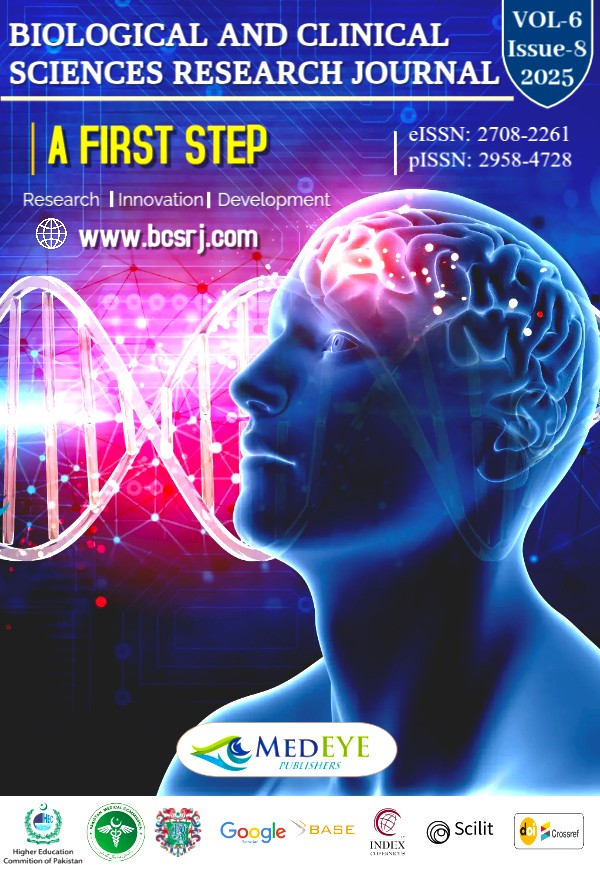Isolation and Characterization of Plant Growth Promoting Endophytic Bacteria From Peganum Harmala L
DOI:
https://doi.org/10.54112/bcsrj.v6i8.1975Keywords:
Endophytic Bacteria, Biofertilizer, Peganum harmala, Biocontrol, and Bacillus spAbstract
Endophytes are increasingly recognised as a sustainable alternative to chemical fertilisers and pesticides in modern agriculture. Syrian rue (Peganum harmala L.) is a medicinal plant of importance, yet no prior studies have reported the isolation of bacterial endophytes from its stem. Objective: To isolate, identify, and evaluate the plant growth-promoting and biocontrol potential of bacterial endophytes from the stem of Peganum harmala. Methods: This experimental study involved the isolation of six bacterial endophytes from the stem of P. harmala. Strains were identified using 16S rRNA gene sequencing, which revealed the presence of Bacillus stercoris, B. tropicus, Staphylococcus simiae, Cladifontibacillus erzurumensis, B. subtilis, and B. mobilis. Biochemical characterisation was performed to assess phosphate solubilization, siderophore production, ammonia and HCN production, hydrolytic enzyme activities (cellulase, protease, and pectinase), and indole-3-acetic acid (IAA) production with and without tryptophan supplementation. Antifungal activity against Aspergillus niger and Rhizoctonia solani was tested. Furthermore, the impact of bacterial inoculation on tomato seed germination and seedling growth (Solanum lycopersicum) was evaluated under controlled conditions. Results: B. mobilis demonstrated the strongest phosphate solubilization ability (4.0 ± 0.2 mm), while both B. tropicus and B. mobilis showed superior siderophore, ammonia, and HCN production. All isolates exhibited diverse hydrolytic enzyme activities, with B. stercoris showing the highest cellulase activity (13.8 ± 0.4 mm), B. tropicus demonstrating the greatest protease activity (7.6 ± 0.5 mm), and both B. stercoris and C. erzurumensis producing prominent pectinase zones (24 ± 0.3 mm). IAA production ranged between 4.9 and 5.9 µg/mL without tryptophan and 10.6 and 12.8 µg/mL with supplementation. Except for S. simiae, all isolates exhibited strong antifungal activity. Among plant assays, B. tropicus notably enhanced tomato seed germination compared to the uninoculated control. Conclusion: The identified endophytic bacterial strains, particularly B. tropicus and B. mobilis, demonstrated significant plant growth-promoting and antifungal properties. These strains hold potential as eco-friendly biofertilizers and biocontrol agents, offering sustainable alternatives to chemical inputs in agriculture.
Downloads
References
Abbamondi GR, Tommonaro G, Weyens N, Thijs S, Sillen W, Gkorezis P, et al. Plant growth-promoting effects of rhizospheric and endophytic bacteria associated with different tomato cultivars and new tomato hybrids. Chem Biol Technol Agric. 2016;3(1):1–10. https://doi.org/10.1186/s40538-015-0051-3
Abdel-Hamid MS, Atta HM, Abo El-Ela HK, El-Ghamry AA, Fouda A. Isolation and characterization of geranium (Pelargonium graveolens) bacterial endophytes. Egypt J Appl Sci. 2022;37(1–2):31–57.
Adinarayana K, Ellaiah P, Prasad DS. Purification and partial characterization of thermostable serine alkaline protease from a newly isolated Bacillus subtilis PE-11. AAPS PharmSciTech. 2003;4(4):56. https://doi.org/10.1208/pt040456
Ahmad F, Ahmad I, Khan MS. Screening of free-living rhizospheric bacteria for their multiple plant growth-promoting activities. Microbiol Res. 2008;163(2):173–81. https://doi.org/10.1016/j.micres.2006.04.001
Aslam N, Wani AA, Nawchoo IA, Bhat MA. Distribution and medicinal importance of Peganum harmala: a review. Int J Adv Res. 2014;2(2):751–5. [No DOI assigned]
Bibi F. Diversity of antagonistic bacteria isolated from medicinal plant Peganum harmala L. Saudi J Biol Sci. 2017;24(6):1288–93. https://doi.org/10.1016/j.sjbs.2015.09.021
Bibi F, Yasir M, Song GC, Lee SY, Chung YR. Diversity and characterization of endophytic bacteria associated with tidal flat plants and their antagonistic effects on oomycetous plant pathogens. Plant Pathol J. 2012;28(1):20–31. https://doi.org/10.5423/PPJ.OA.06.2011.0123
Brink B. Urease test protocol. ASM. 2010:1–7.
Chaudhary P, Agri U, Chaudhary A, Kumar A, Kumar G. Endophytes and their potential in biotic stress management and crop production. Front Microbiol. 2022;13:1–22. https://doi.org/10.3389/fmicb.2022.933017
Cho KM, Hong SY, Lee SM, Kim YH, Kahng GG, Lim YP, et al. Endophytic bacterial communities in ginseng and their antifungal activity against pathogens. Microb Ecol. 2007;54(2):341–51. https://doi.org/10.1007/s00248-007-9208-3
Das G, Prasad MP. Isolation, purification, and mass production of the protease enzyme from Bacillus subtilis. Int. Res. J. Microbiol. 2010;1(2):26–31.
Dashti AA, Jadaon MM, Abdulsamad AM, Dashti HM. Heat treatment of bacteria: A simple method for DNA extraction in molecular techniques. Kuwait Med J. 2009;41(2):117–22. [No DOI assigned]
Diaz PL, Hennell JR, Sucher NJ. Genomic DNA extraction and barcoding of endophytic fungi. In: Plant DNA Fingerprinting and Barcoding: Methods and Protocols. Methods Mol Biol. 2012;862:171–9. https://doi.org/10.1007/978-1-61779-609-8_14
Glick BR. Plant growth-promoting bacteria: mechanisms and applications. Scientifica. 2012;2012:1–15. https://doi.org/10.6064/2012/963401
Hassan SED. Plant growth-promoting activities for bacterial and fungal endophytes isolated from medicinal plant Teucrium polium L. J Adv Res. 2017;8(6):687–95. https://doi.org/10.1016/j.jare.2017.09.001
Hendricks CW, Doyle JD, Hugley B. A new solid medium for enumerating cellulose-utilizing bacteria in soil. Appl Environ Microbiol. 1995;61(5):2016–9. https://doi.org/10.1128/aem.61.5.2016-2019.1995
Kumar A, Sharma R. Production of alkaline pectinase by bacteria (Cocci sps.) isolated from decomposing fruit materials. J Phytol. 2012;4(1):1–5. [No DOI assigned]
Kumar P, Dubey RC, Maheshwari DK. Bacillus strains isolated from the rhizosphere showed plant growth-promoting and antagonistic activity against phytopathogens. Microbiol Res. 2012;167(8):493–9. https://doi.org/10.1016/j.micres.2012.05.002
MacWilliams MP. Citrate test protocol. ASM. 2009:1–7. [No DOI assigned]
Malfanova NV, Lugtenberg B, Berg G. Endophytic bacteria with plant growth-promoting and biocontrol abilities. Leiden University Repository. 2013:15–37. [Doctoral thesis; No DOI assigned]
Marques AP, Pires C, Moreira H, Rangel AO, Castro PM. Assessment of the plant growth promotion abilities of six bacterial isolates using Zea mays as an indicator plant. Soil Biol Biochem. 2010;42(8):1229–35. https://doi.org/10.1016/j.soilbio.2010.04.014
McDevitt S. Methyl red and Voges–Proskauer test protocols. ASM. 2009;8(1):1–9. [No DOI assigned]
Nagda V, Gajbhiye A, Kumar D. Isolation and characterization of endophytic fungi from Calotropis procera for their antioxidant activity. Asian J Pharm Clin Res. 2017;10(3):254–8. https://doi.org/10.22159/ajpcr.2017.v10i3.16076
Nautiyal CS. An efficient microbiological growth medium for screening phosphate-solubilizing microorganisms. FEMS Microbiol Lett. 1999;170(1):265–70. https://doi.org/10.1111/j.1574-6968.1999.tb13383.x
Patil RC, Jadhav BL. Isolation and characterization of protease-producing Bacillus species from the soil of the dairy industry. Int J Curr Microbiol Appl Sci. 2017;6(6):853–60. [No DOI assigned]
Rashid S, Charles TC, Glick BR. Isolation and characterization of new plant growth-promoting bacterial endophytes. Appl Soil Ecol. 2012;61:217–24. https://doi.org/10.1016/j.apsoil.2011.09.011
Shim J, Kim JW, Shea PJ, Oh BT. IAA production by Bacillus sp. JH 2-2 promotes the growth of Indian mustard in the presence of hexavalent chromium. J Basic Microbiol. 2015;55(5):652–8. https://doi.org/10.1002/jobm.201400311
Sundara B, Natarajan V, Hari K. Influence of phosphorus-solubilizing bacteria on the changes in soil available phosphorus and sugarcane and sugar yields. Field Crops Res. 2002;77(1):43–9. https://doi.org/10.1016/S0378-4290(02)00048-5
Wagi S, Ahmed A. Bacillus spp.: potent microfactories of bacterial IAA. PeerJ. 2019;7:e7258. https://doi.org/10.7717/peerj.7258
Downloads
Published
How to Cite
Issue
Section
License
Copyright (c) 2025 Zainab Zobala Babar, Tahira Younis, Zabta Khan Shinwari

This work is licensed under a Creative Commons Attribution-NonCommercial 4.0 International License.








